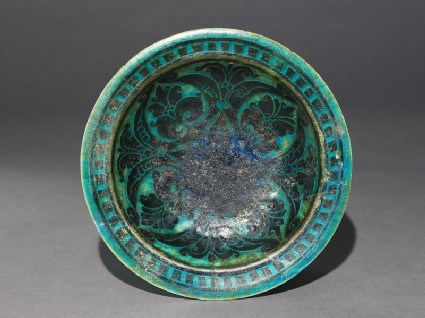Browse: 248 objects
- Reference URL
Actions
Footed dish with palmettes
-
Details
- Associated place
- Date
-
2nd half of the 12th century
Great Seljuq Period (1040 - 1194)
- Material and technique
- fritware, with decoration carved through a black slip under a turquoise glaze
- Dimensions
-
5.6 cm (height)
20 cm (diameter)
- Material index
- Technique index
- Object type index
- No. of items
- 1
- Credit line
- Presented by Sir Alan Barlow, 1956.
- Accession no.
- EA1956.130
-
Further reading
Allan, James W., Islamic Ceramics, Ashmolean-Christie's Handbooks (Oxford: Ashmolean Museum, 1991), no. 9 on p. 20, illus. p. 21
Fehérvári, Géza, Islamic Pottery: A Comprehensive Study Based on the Barlow Collection (London: Faber and Faber, 1973), no. 80 on p. 82, pl. 35 a
Allan, James W., Medieval Middle Eastern Pottery (Oxford: Ashmolean Museum, 1971), p. 24
Glossary (3)
fritware, glaze, slip
-
fritware
Ceramic material composed of ground quartz and small quantities of clay and finely ground frit (frit is obtained by pouring molten glass into water).
-
glaze
Vitreous coating applied to the surface of a ceramic to make it impermeable or for decorative effect.
-
slip
A semi-fluid clay applied to a ceramic before glazing either to coat the surface or for decorative effect.
Location
-
- currently in research collection
Objects are sometimes moved to a different location. Our object location data is usually updated on a monthly basis. Contact the Jameel Study Centre if you are planning to visit the museum to see a particular object on display, or would like to arrange an appointment to see an object in our reserve collections.
Publications online
-

Islamic Ceramics
This footed dish belongs to a group of ceramics commonly known as ‘silhouette ware’. Like no. 6 [EA1956.91], it is decorated with a clay slip. Here, however, the slip is not used for painting. Instead the object has been dipped into a thick black slip, and when dry the slip has been carved away to leave the design in relief on a white ground. The subsequent turquoise glazing gives the dish its final black and turquoise, colour scheme.
Once again we see the Islamic taste for balanced geometric forms around a central point. Here, as in no. 6 [EA1956.91], the design is cruciform, this time each arm a palmette within a heart-shaped cartouche, the cartouches themselves being formed by half-palmettes. The half-palmette is the basis of what we, in the West, call the ‘arabesque’. To form a simple arabesque, split a palmette down the centre lengthwise. Now attach the resulting half-palmettes to an s-shaped stem in such a way that the half-palmettes are in line with one another, but on the alternate sides of the stem. There are of course infinite variations on this theme, depending on the form of the original palmette and the space needing to be filled by the resulting arabesque.
© 2013 University of Oxford - Ashmolean Museum





